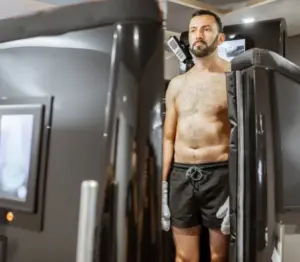The benefits of cryotherapy chambers have become well-liked in the fitness and wellness communities. Cryotherapy, derived from the Greek words “cryo” (cold) and “therapy” (treatment), means exposing the body to extremely low temperatures for several minutes.
Cryotherapy believers testify to its capacity to lessen chronic pain, increase energy, and decrease inflammation. However, what makes this cold therapy so successful, and how does it work exactly? Let’s get started!
Table of Contents
What is cryotherapy?

Cryotherapy has its origins in ancient cultures when cold therapies were employed to reduce inflammation and discomfort. Dr. Toshima Yamauchi created modern cryotherapy in Japan in the late 1970s to treat rheumatoid arthritis. Since then, it has changed as ongoing research has increased its effectiveness and extended its range of uses.
The use of cold temperatures for therapeutic purposes is known as cryotherapy. It can be applied locally, in a very specific manner, or more broadly, to cause your entire body to react in a specific way.
Coolant sprays or ice baths, ice packs or massages, or even specific scanners that reduce tissue temperature are all examples of local cryotherapy. However, whole-body cryotherapy requires placing your entire body in extremely low temperatures for a short period. This may be beneficial to your overall health. The doctor treating you may suggest cryotherapy for:
- Bone cancer.
- Prostate, liver, or cervical cancer.
- Cervical (lower end of the uterus) precancerous cells.
- Early-stage skin cancers, such as squamous cell cancer and basal cell cancer, as well as tumors skin diseases.
- Childhood retinal cancer is known as retinoblastoma.
- Skin disorders such as black patches, skin tags, or warts.
How does cryotherapy work?

Treatment using cold temperatures is referred to as cryotherapy. Cold therapy is another name for it. The purpose for which you are receiving treatment will determine how it operates and how the treatment process goes. The three primary forms of cryotherapy have been briefly discussed, along with what to expect during treatment.
Cryotherapy for cancer
Different forms of cancer can be treated and prevented by cryotherapy. Other names for it include cryoablation and cryosurgery. Instead of affecting the entire body, it targets the cancer and only kills the cancer cells in extremely cold temperatures.
Cryotherapy involves a physician spraying or cleaning liquid nitrogen into the affected area to treat skin cancer. Because liquid nitrogen is so cold, it freezes the region, which kills the cancer cells. The dead cancer cells fall off with the scab that has formed on the skin.
Neck abnormal or precancerous cells can also be treated using cryotherapy. A trained nurse or physician applies liquid nitrogen to the abnormal spot inside the womb using a device known as a cryoprobe. The cells are frozen and destroyed as a result.
Immersion in Cold Water
Cold-water immersion, often known as cold water therapy, includes cold showers, cold water plunges, and ice baths. You would usually immerse your body below the neck in water that is between 50 and 59°F (10 and 15°C) for 5 to 15 minutes when doing cold-water immersion. Cryotherapy of this type is usually used to help reduce post-exercise discomfort.
Use of Ice

For injuries like sprains, strains, and fractures, applying cold packs is the primary line of therapy. Icing helps lessen post-exercise soreness. Ice can help reduce inflammation, pain, and swelling after an accident. It is commonly used in conjunction with elevation, compression, and rest as part of the R-I-C-E to help accelerate the healing process.
Cryotherapy for skin conditions
Skin problems like verrucas and warts that are limited can be treated with cryotherapy. If salicylic acid-containing prescription drugs have not worked, a doctor will typically advise this. Using liquid nitrogen to freeze the affected area is known as cryotherapy.
The treated region develops a scab, which eventually falls off with the dead cells. It may require a few sessions to fully function. Most people discover that their skin appears entirely normal after treatment, with no trace of the lesion’s previous location. Cryotherapy may result in a permanent white mark or scar.
Cryotherapy for the entire body
Whole-body cryotherapy is used to treat general ligament and muscle pain as well as chronic pain from diseases like osteoarthritis or rheumatoid arthritis. Extremely low temperatures (below -80° C) are used in the treatment to activate the body.
- Osteoarthritis & rheumatoid arthritis.
- Shoulder freezing.
- The fibromyalgia.
- The Tendonitis.
- Strains in the muscles and ligaments.
- Skin disorders like psoriasis and eczema.
You enter a treatment room for a whole-body cryotherapy session wearing shorts and a t-shirt or a swimming suit, along with gloves, stockings, and ear and mouth protection to keep your upper body warm. The cold air in the pod causes endorphins to be released, which activates the body’s natural pain-reduction process by cooling the skin to about 5°C.
This procedure can reduce inflammation and pain brought on by several medical disorders. To maximize their training results, condition their muscles, and help in recovery, professional athletes are also using it more and more.
Benefits of cryotherapy

Reduces symptoms of migraines
By freezing and relaxing the nerves in the neck region, cryotherapy can help reduce migraines. Applying a neckband with two ice packs to the blood vessels in the neck greatly decreased migraine sufferers’ pain. This is believed to function by lowering the temperature of the blood as it flows through mental arteries. The carotid arteries are easily accessible and near the skin’s surface.
Treats mood disorders
Whole-body cryotherapy’s extremely low temperatures can cause physiological and hormonal reactions. This involves endorphins, testosterone, and adrenaline escaping. Those who suffer from mood disorders including depression and anxiety may benefit from this. The benefits of whole-body cryotherapy proved to be a successful short-term treatment for both.
Reduces arthritic pain
There are other successful treatments for critical disorders besides limited cryotherapy; whole-body cryotherapy greatly decreased pain in individuals with arthritis and patients tolerated the treatment well. It made it possible for deeper occupational therapy and physiotherapy. In the end, this increased the effectiveness of rehabilitation programs.
Help in low-risk tumors
It is possible to treat cancer with targeted, local cryotherapy. It is referred to as “cryosurgery” in this context. It functions by encasing cancer cells in ice crystals after they have frozen. There are currently some low-risk tumors for various cancers, such as prostate cancer, that can be treated.
Reduces irritation of nerves
Because cryotherapy may reduce pain, many athletes have been using it for years to treat injuries. An inflamed nerve can become mute from the cold. A tiny sensor that is injected into the surrounding tissue will be used by the doctors to treat the damaged area. Chronic pain, severe wounds, or pinched nerves or neuromas can all be treated with this.
Skin Disorders and Cancer

Skin lesions, moles, and tumors can be removed with cryosurgery, which is a safe and efficient method of destroying cancer cells. Non-medical cryotherapies may help treat eczema-related inflammation and irritation. Whole-body cryotherapy is not a successful treatment for eczema regardless of these findings.
Note: Whole-body cryotherapy is also not advised by the American Academy of Dermatology since it may cause skin damage.
How Cryotherapy Benefits the Skin?

- Benefits for Anti-Aging: Cryotherapy increases collagen, which reduces wrinkles and encourages younger-looking skin.
- Clearer Skin: Cold temperatures effectively treat acne by reducing redness and inflammation.
- Better Skin Texture: Cryotherapy’s increased blood flow produces skin that is more bright and smoother.
- Scientific Support: Research confirms the claim that cryotherapy can increase collagen and improve the condition of the skin.
- Real Results: Clients report better complexions, fewer aging signs, and smoother skin.
Risks of Cryotherapy
Excessive exposure to cold temperatures might cause skin damage. Because whole-body cryotherapy exposes your body to temperatures below freezing, there are more risks involved. Whole-body cryotherapy may carry a few risks:
- Frostbite: After whole-body cryotherapy, many experienced low frostbite due to the freezing of the skin. An unusual case of severe frostbite led to third-degree burns, painful blisters, and edema.
- Rash: If the fatty tissue layer of our skin is damaged by intense cold, this itchy and uneasy rash may appear. The rash may appear as deep lumps, scaly areas, or hard pimples.
- Suffocation: However rare, the vapors from liquid nitrogen chambers can lower oxygen levels in enclosed spaces, leading to fainting or suffocation.
Should I have cryotherapy?
Cryotherapy may also be useful for treating headaches, nerve problems, mood disorders like anxiety and depression, and even some forms of dementia, even with its most common uses including the treatment of skin conditions, cancer, and pain in tendons and muscles.
Conclusion
The Health Benefits of Cryotherapy include pain relief, skin disorders, treatment of mood disorders, reduced arthritic pain, help in tumors, and decreased inflammation to improve sports recovery and mental health improvement. Although it’s not a general treatment, many people find it to be a beneficial supplement to their wellness routine.
Cryotherapy offers a unique and effective technique to boost your skin’s health and appeal. Cryotherapy could be an option for acne, seeking anti-aging treatments, or improving your skin’s overall health. Speak with a skincare expert to learn how cryotherapy can be included in the routine and to witness the life-changing results for yourself!






